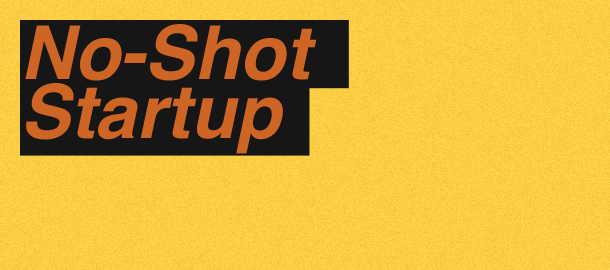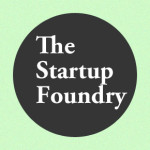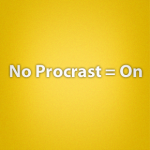Welcome to The Startup Foundry.
Hopelessly perfect: Why it’s smart to work at a no-shot startup
Guest Author
TSFPublished: Jul 7, 2011 4:27 pm

Think about the promise of the Valley. Rampant hiring. Early-stage capital freely flowing to countless companies. Catered lunches and dinners. Worthy engineers treated like royalty (or worse, ninja / pirate / rockstars).
While some companies do fit the Valley pipe-dream, we think there are many more startups who don’t have a shot at VCs, the top engineers in the world, or an ice cube’s chance in Hell at realizing those paper stock options. And guess what: We think it’s still a smart idea to work with them. We call them the no-shot startup, and it can be an invaluable experience, just as long as you know what to expect and when to quit.
Hopeful startups
The startup lifestyle happened a bit backward for me. I accidentally worked for a successful and notable startup first, then started loving the startup lifestyle a few years later.
I started out as an early reader of blogs. Specifically tech blogs. I became obsessed with Engadget in 2004 after seeing it continue to pop up on Slashdot. I read every post. I spent hours during my senior year in college, and read countless posts while cutting and pasting graphics for a local television station— my first job out of college.
Since I was spending all my time reading Engadget, I figured that was a good sign of where my career should go. I dreamed of creating a new version of the defunct TechTV cable network, but on the web. I reached out to Peter Rojas and Ryan Block to become their audio podcast producer, and they accepted my offer to work for free.
Free turned to paid, and Engadget turned out to be part of Weblogs, Inc., a startup founded by Jason Calacanis, Brian Alvey, and Engadget founder Peter Rojas. Their ambitious goal was to change the publishing world as we knew it. They thought the big guys (CNET, PC Mag, and any mainstream-media publication) were covering technology and other verticals (cars, video games, etc) in an extremely lazy and uninteresting fashion. Traditional publications would be spoon fed press releases. They’d go on junkets. They’d go to CES, get all their stories, and then push them out over the next few months. Peter’s model was be different. He’d focus on speed and breadth, crafting dozens of 75-150 word posts per day, and win over the hardcore readers. It worked.
Through extremely focused hard work, Engadget saw great success and obviously still enjoys a leading seat at the big kids table of technology journalism.
For me, Engadget meant watching courtside as Peter, Ryan, and the Weblogs, Inc. crew made Engadget, Autoblog, TUAW, Joystiq and other brands become among the most respected publications in their respective verticals in a matter of a few years.
From success to suck
Weblogs, Inc. had done it. We eventually were sold to AOL, as one of the first notable Web 2.0 acquisitions (post-Flickr, pre-YouTube). I moved to New York City and started working on projects as a part of AOL. I was living the life of a post-acquisition startup.
Then, tragedy struck. My brother died in a car accident.
I was devastated. I felt like I had to move back to Utah to help my family, and to help myself.
So there I was. Back in a fly-over state. Back working for a TV station again. I was back on the corporate career path.
The second time around, I worked for a CBS Owned-and-operated station in Utah. As the smallest station on the CBS food chain (market 32), our corporate parents made most of our decisions, and set the direction for our station. That felt awful. We didn’t control our destiny, and we had to beg and justify every business decision.
Feeling the stark contrast from corporate red-tape to Weblogs, Inc., where anyone in the company could simply roll up their sleeves and get something done, I figured rather than suffer in an environment that I hated, I should probably just get out there and start something with some buddies. After all, Brian Alvey and Jason Calacanis were high school friends who ended up with a killer startup, and were now wealthy thanks to AOL’s buyout. I was sure my next startup would be exactly like that. (Naive, to say the least.)
I started meeting all the like-minded folks in my area who dreamed of changing the world. One of the guys I met, I’ll call him “Steve”, came to me and tried to convince me to change the world with him. His vision? A Wikipedia like experience where instead of collaborating to create an encyclopedia, users collaborated to review places. “Yelp meets Wikipedia.”
His energy was infectious. He seemed like he had really thought this vision through, and there was a shot at making something interesting. We figured we’d make money by selling NPS-style data to corporations and they’d get feedback about what users thought. Win-win.
Rather than focus on things like proving hypotheses, or getting our product out the door and tested, we’d instead have day-long grandiose whiteboarding sessions with two other suckers coworkers who were convinced to join. We’d figure out the intricacies of our product, talk about vision, explain why it’s perfect for everything from dentist reviews to deciding our next presidential candidate. All while we were developing a product in a vacuum.
We had no users. All we had was our ideas. The longer we took developing our ideas, the more it felt like we were working.
On top of our ill-conceived business planning, we had managed to snare a real estate investor to put some money into our project. Spoiler alert: Uninformed investor meets uninformed startup founders. Fiscal hilarity and drama ensues.
I spent three months at this startup and we never put out a product that attracted any real users. According to our business plan, month three was when we were supposed to start generating revenue. We were hopeless.
With my meager post-college savings wiped, a substantial amount of debt incurred, no product / users / revenue to show for our efforts, and feeling scorned, I left my no-shot startup to move to Boston where a different startup could use my talents.
The anatomy of a no-shot startup
After all that, I still look back and still think this experience was among the most important experiences in my life professionally. It felt like I contributed little to the outcome of the startup, positive or negative, but I was able to watch, absorb, understand and identify traits and styles which I wanted to use in future business endeavors. Additionally, I was able to literally try anything, as long as I could somehow justify it to my coworking brethren.
No-shot startups exist in a space where enthusiasm meets inexperience. I’d say that most, but not all, no-shot startups are created by technically minded power users with little actual coding experience. They think they have a big idea they think the world should witness. They look at the success of companies like YouTube, LinkedIn, and Groupon as proof that anyone with a good idea and some moxy can pull off a multi-million dollar exit. To be clear, No-shot doesn’t mean doomed to fail, but it does mean that the deck is stacked against the company.
The upside of the no-shot founder? They know nothing, and they hold nothing back. They’re willing to push forward regardless of the odds. Skillful hopeless founders tend to attract people and sell them on their idea. Some might even convince their uninformed friends and acquaintances to quit jobs and work on the hopeless project full-time.
The downside of the no-shot founder? Without the means to create a prototype or build anything themselves, they resort to desperate measures like offshore outsourced development of core technologies. They spend hours creating a complex capitalization structure before having a product. They create two sided marketplaces with no idea of how to capture either side. They convince friends and family to loan them money, which has no shot of being paid back.
In short, they over promise and under deliver for everyone in the equation.
The startup spectrum
To be clear, no-shot startup-dom is not a binary situation. At one end you have completely hopeless startups like the one I joined. At the other are “scrappy” startups that might start out seemingly hopeless, but through sheer determination, end up giving themselves a shot. AirBnb is a great example of the “scrappy” side.
At some point, there’s an event or series of events which moves a startup from scrappy and disadvantaged, to scrappy and legit. Normally that’s through social proof of some sort, like a big name investor, big name client, or actual user traction. That turns scrappy startups into “legit scrappy” startups. These are the ones you read about on TechCrunch like YoBongo, ZeroCater, or ones that might be funded by Y Combinator.
All the way at the other end of the spectrum are big-shot startups. These are the ones like Quora, FourSquare, and Color, where the founders are either already proven enough to attract legit investor attention, or, in the case of a lot of ad networks, they have enough friends in high places to score them VC money.
To work in startups, work in startups
If you’ve already identified that your goal is not to work for soulless companies, you need to start working for startups. Ideally, you should try to find a startup that shares your values, aligns with your career objectives and do it with people who you like.
Ideally, everyone would start out with a well formed set of skills, and obviously be able to contribute greatly to a big name startup. Good quality coders from a notable school (MIT, Stanford, etc) automatically get their pick of where to start on the spectrum. For you, we’d recommend landing somewhere in the “scrappy” part of the spectrum.
However, for you wanna-be business cofounders without legit coding skills, there’s a big way for you to contribute. For hopeless startups, you just need to show up. Show up and be willing to hustle your way through your hopeless startup. Read every business blog you can, and start to identify problems with your no-shot startup as soon as you can.
The no-shot startup advantage
Crucially, the biggest advantage of working lower down the spectrum is that mistakes don’t stick with you. In general, mistakes don’t typically stick with you, but the further up the spectrum you go, the tighter knit the community. Make a mistake at the bottom of the spectrum, and there’s enough people making mistakes that it’s unlikely your mistakes will give you a bad reputation. On the other hand, screw up a company with $41mm in funding, and those mistakes are more likely to follow you.
After the no-shot startup
Chances are, if you’re reading this after the publication date, someone sent you this essay because you’re in a sketchy spot. You’ve worked with a startup that just isn’t going anywhere, and you’re wondering where to go next.
My simple advice is to move on to the next one. Work with people who are smarter than you. For me, that meant moving to San Francisco and working with some of the smartest and most talented folks I’ve ever been around. For you, it might mean getting more domain knowledge in your favorite topic area. Maybe even working at a corporation that plays in your area of expertise.
Whatever you do: Move up the spectrum. Don’t spend your time bouncing from no-shot startup to no-shot startup. I know those people. They dream big, but never realistically. If your first company didn’t have a launched product, be an employee at one that has a product that has minor traction. Work in support for a funded company. Work on side projects to show how valuable you can be.
It’s not an all-or-nothing thing. Focus on diverse professional experience, and you’ll give yourself the best shot you have available now.
For more startup news, follow us on Twitter @startupfoundry or on Facebook.
-
👉 Filed Under.
Categorised in: Bootstrapped, Culture
Get Connected:
If you like startups, join our weekly mailing list. Good startup content, no fluff.
👇

Hi, I'm Paul Hontz.
I'm a YC alumn and I love startups. I created TSF to highlight companies I find interesting. You can learn more about me here.
Recent Posts:

The Story of Cruise (YC W14): How 4 people built a self driving car in 7 months.
Jul 8, 2014 2:35 pm

I Want To Write About Your Startup – Relaunching TSF
Jan 17, 2014 5:14 pm

How To Do B2B Email Sales
Nov 23, 2011 2:12 pm

Nasty Bug in iOS 5.0.1 OTA Update screws up Address Book on the iPhone 4S
Nov 10, 2011 11:56 pm

It’s Easier to Answer to Your Code Than Your Customers
Oct 28, 2011 2:25 pm


